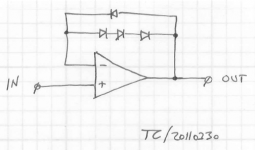First off, this question is regarding instrument amplifiers, and not any amp of the super-high-fidelity variety. Clipping is welcome by many musicians, as long as it isn't constantly sounding like a shaking sack of chainsaws.
Solid state amps, in my opinion, are great for everything except tone and distortion. Regarding the latter, are there any ways that one could reliably reduce the harshness of overdriven solid state amps, but not totally remove it with a limiter or compressor? I'm pretty sure a tube buffer would work, but then the amp would be a mutt. Another possibility I think would work is having anode-to-anode zener diodes in a feedback loop somewhere after the main amplification stage, which would make the signal less jagged. Just FYI, I'm planning to modify a Fender Rumble 15 bass combo (which sounds like crap if I have the volume up to any enjoyable level) and currently have no high-power plans.
Solid state amps, in my opinion, are great for everything except tone and distortion. Regarding the latter, are there any ways that one could reliably reduce the harshness of overdriven solid state amps, but not totally remove it with a limiter or compressor? I'm pretty sure a tube buffer would work, but then the amp would be a mutt. Another possibility I think would work is having anode-to-anode zener diodes in a feedback loop somewhere after the main amplification stage, which would make the signal less jagged. Just FYI, I'm planning to modify a Fender Rumble 15 bass combo (which sounds like crap if I have the volume up to any enjoyable level) and currently have no high-power plans.
You can use the zener diodes along with a small series resistor (for amplifier feedback loop stability). This is similar to what I do - except I run the feedback from the VAS to the input; the output stage runs as an open-loop buffer.
Do note the zener diode voltages you select have to be similar (and less) to the output swing of your power amplifier.
Do note the zener diode voltages you select have to be similar (and less) to the output swing of your power amplifier.
You can use the zener diodes along with a small series resistor (for amplifier feedback loop stability). This is similar to what I do - except I run the feedback from the VAS to the input; the output stage runs as an open-loop buffer.
Do note the zener diode voltages you select have to be similar (and less) to the output swing of your power amplifier.
allright, thanks for the resistor tip! would you suggest measuring for the closest possible zener voltages in each, or would it be better to have some difference and get some nice asymmetrical clipping?
Most solid state amplifiers you have heard (and overloaded) will be using a Global Negative FeedBack loop.
The feedback tries very hard to minimise all the aberrations you don't want to hear. It does this brilliantly until they simply give up and say I can't do this anymore !
They then let out the distortion of a clipped signal without correction from the NFB.
If you use a SS amplifier that has at least one stage that is not inside a NFB loop then that stage will gradually change in sound character as the signal level is increased. This is already done with valve amps. Do the same with SS and you can to some extent copy the valve soft overload sound.
A SE stage (without feedback) develops 2nd harmonic from quite low levels and this becomes stronger with increasing level.
The feedback tries very hard to minimise all the aberrations you don't want to hear. It does this brilliantly until they simply give up and say I can't do this anymore !
They then let out the distortion of a clipped signal without correction from the NFB.
If you use a SS amplifier that has at least one stage that is not inside a NFB loop then that stage will gradually change in sound character as the signal level is increased. This is already done with valve amps. Do the same with SS and you can to some extent copy the valve soft overload sound.
A SE stage (without feedback) develops 2nd harmonic from quite low levels and this becomes stronger with increasing level.
Exactly what Andrew says - the VAS stage is our Class-A amplifier, and using the zener diode feedback loop there also prevents the stage from "sticking" during clipping.
The rule-of-thumb I use is to select the zener diode to be no higher than 15V, and use the series resistor to shape the overload threshold.
And yes, you can use different values; Crate did the same trick in their ValveTube series.
I believe they used 3.3V and 6.8V - I just used 4.7V (this is in the PREAMP stage).
The rule-of-thumb I use is to select the zener diode to be no higher than 15V, and use the series resistor to shape the overload threshold.
And yes, you can use different values; Crate did the same trick in their ValveTube series.
I believe they used 3.3V and 6.8V - I just used 4.7V (this is in the PREAMP stage).
- Status
- This old topic is closed. If you want to reopen this topic, contact a moderator using the "Report Post" button.
- Home
- Amplifiers
- Chip Amps
- Softening of solid state distortion?
